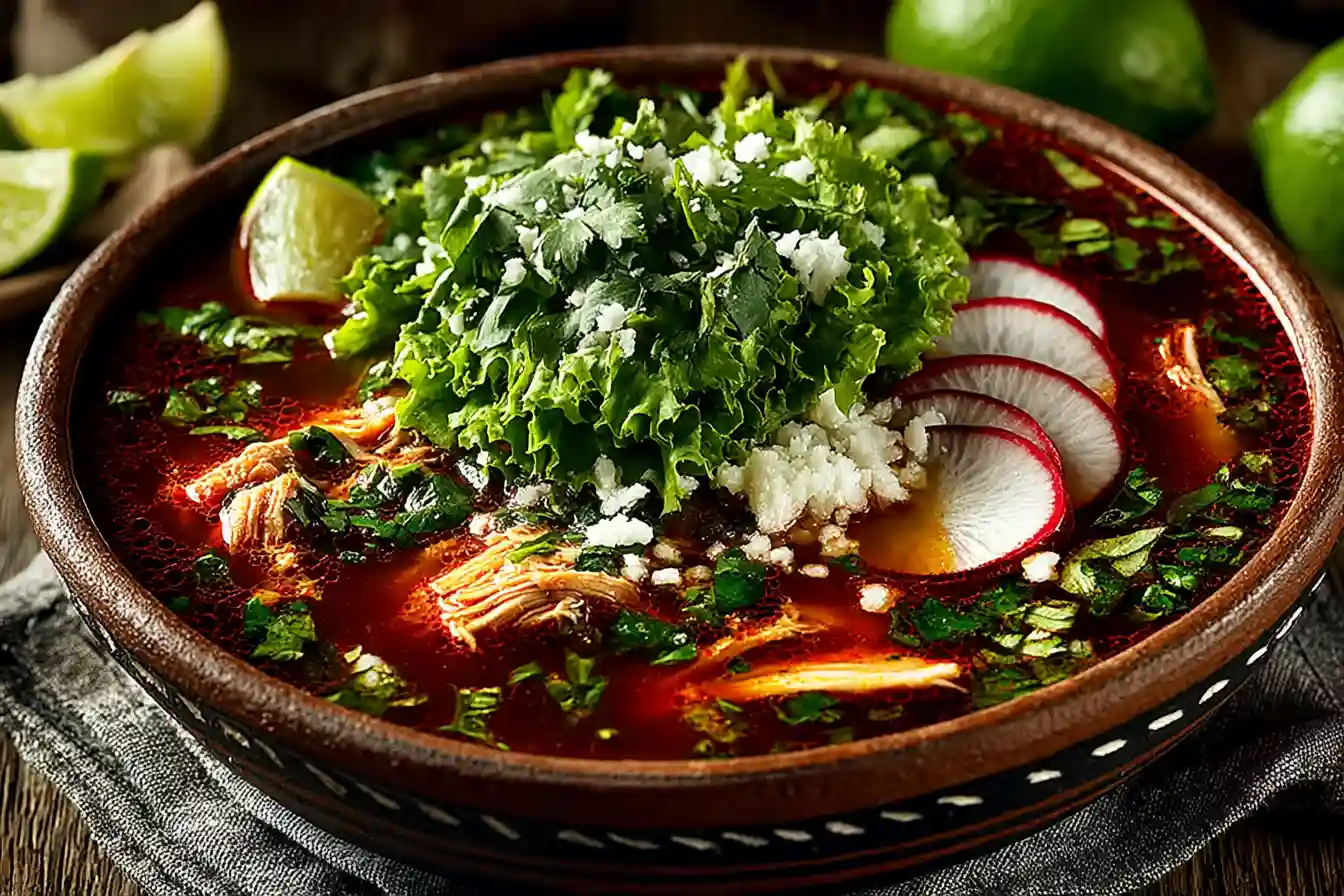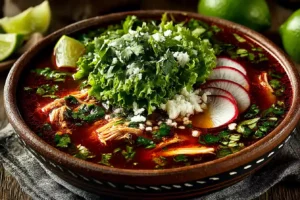Before we dive into the full recipe, let’s talk about why Pozole Rojo has captured hearts across kitchens. This article walks you through the authentic preparation, the deep cultural meaning behind every bowl, and a few insider tips I’ve learned from my own kitchen adventures. Whether you’re simmering it for a cozy weekend or celebrating with friends, Pozole Rojo isn’t just food it’s a story of love, tradition, and comfort shared one spoonful at a time.
Table of Contents
Memories of Pozole Rojo and Family Gatherings
I can still picture my grandmother’s kitchen on chilly Sunday afternoons the air filled with the earthy scent of dried chiles and slow-cooked pork. Back then, I didn’t know this dish was called Pozole Rojo, I just knew it meant family. She’d stir the pot with care, humming softly, while I stood beside her learning that good food takes patience and heart. Today, when I make my own version, I’m reminded of those simple moments that shaped my love for cooking.
It’s the kind of recipe that connects generations. Every home has its variation some add garlic by the handful, others prefer more chile guajillo for depth. But what never changes is the joy that rises with the steam when you lift the lid. At my Asheville cooking classes, I love showing students how to make Pozole Rojo because it brings everyone together no matter where they’re from.
What Makes Pozole Rojo Special in Mexican Cuisine
Unlike other stews, Pozole Rojo recipes carries centuries of culture in every bite. It’s traditionally served during holidays like Mexican Independence Day, but in many homes, it’s comfort food all year long. The blend of nixtamalized hominy, tender pork, and smoky chiles creates a harmony that’s rich, bold, and unmistakably Mexican.
As the pot simmers, you can almost hear the stories it holds family tales, laughter, and traditions passed down through generations. Cooking it isn’t about rushing; it’s about honoring the process. Every simmered minute rewards you with depth and warmth, a perfect example of how food connects us to our roots.
Key Ingredients and Preparation Basics
The Heart of Pozole Rojo: Hominy, Chiles, and Pork
Making Pozole Rojo starts with understanding its soul the ingredients. This isn’t just another stew; it’s a balance between texture, spice, and comfort. The three essentials are hominy, dried chiles, and pork shoulder. Hominy gives the dish its body, a nutty corn base that absorbs all those rich flavors from the broth. The pork, simmered slowly, adds a savory depth that makes every bite satisfying.
You’ll need guajillo, ancho, or even pasilla chiles to create that distinct red hue. Each brings its personality smoky, slightly sweet, or deeply earthy. Toasting and soaking them before blending unlocks their flavor and turns the sauce into that velvety, crimson base you’ll recognize instantly.
I always tell my cooking students that the key to a good Pozole Rojo lies in patience. Let the broth simmer gently until the flavors marry and the pork is tender enough to fall apart with a fork. For those who love creamy textures in soups, you might also enjoy my Corn Chowder Recipe, which celebrates corn in a completely different but equally comforting way. Both dishes show how a humble grain can transform a meal.
Choosing the Right Chiles for Authentic Flavor
The red in Pozole Rojo isn’t just for looks; it’s the foundation of its taste. Traditional cooks use dried guajillo and ancho chiles for their balanced flavor warm but not overpowering. If you’re new to Mexican cooking, don’t worry. These chiles are mild enough to let you appreciate their complexity without setting your mouth on fire.
Blend them with garlic, onion, and a little broth to form a rich paste that you’ll later stir into the soup. This paste gives the stew its signature color and that smoky undertone you can’t fake. Once mixed with hominy and pork, the aroma fills the kitchen with something that feels like home.
I like pairing this section of my class with a comparison to Chicken Tortilla Soup, another favorite that builds flavor through toasted spices and layered toppings. Both recipes show how Mexican soups rely on patience and spice harmony rather than complexity. If you’re exploring other cozy bowls, you might also try the Easy Lasagna Soup it’s Italian comfort with a similar heartwarming energy.
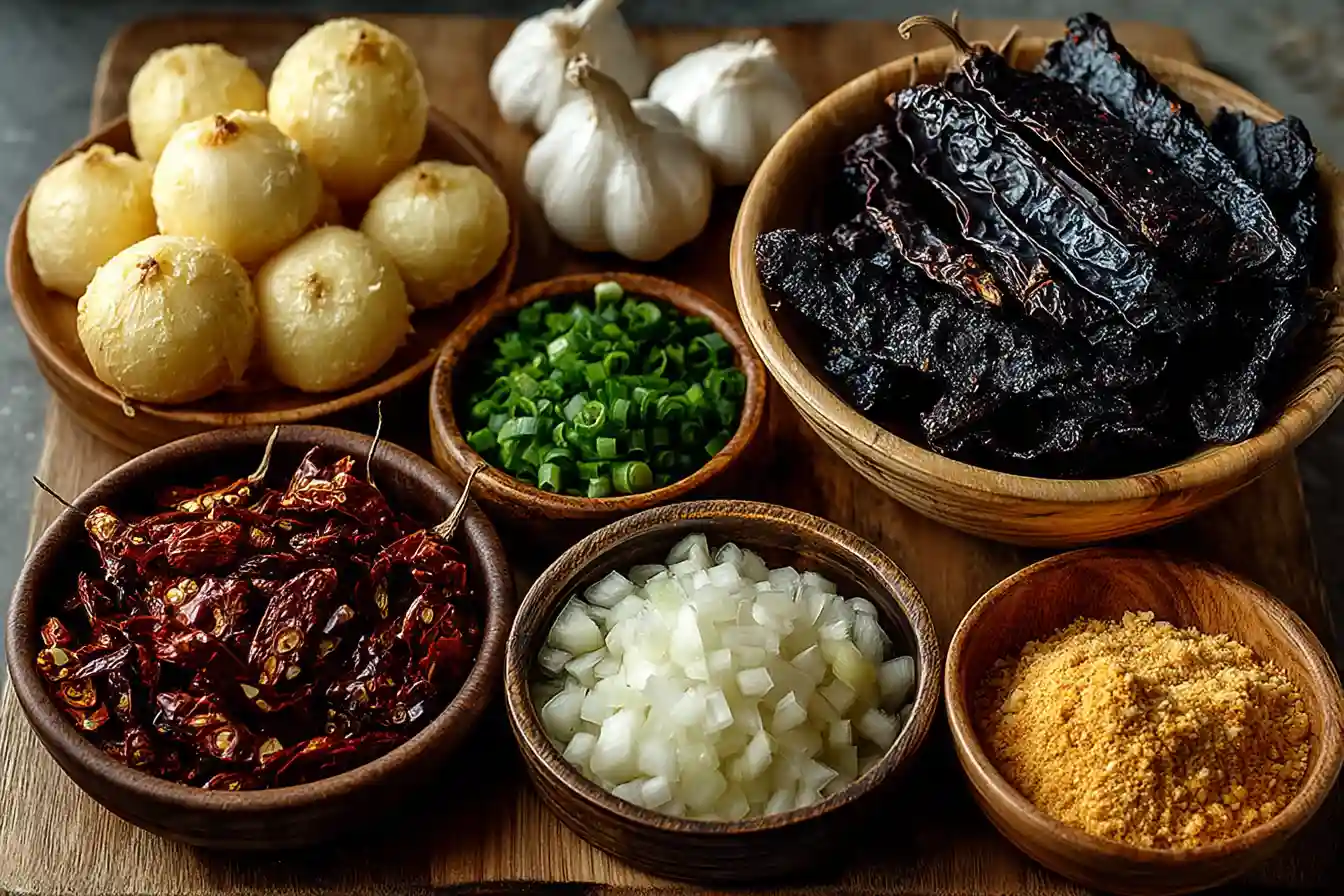
Cooking Pozole Rojo the Right Way
Step-by-Step Guide to a Perfect Pozole Broth
Cooking Pozole Rojo is a calm, rewarding process that turns simple ingredients into something truly special. Begin by rinsing the hominy and placing it in a large stockpot. Add enough water to cover and simmer it until the kernels bloom and soften. This step takes time, but it’s what gives Pozole Rojo its signature texture and heartiness.
While the hominy cooks, prepare the red chile sauce the soul of the dish. Toast dried guajillo and ancho chiles lightly in a dry skillet, just until their aroma rises. Soak them in warm water for ten minutes, then blend them with garlic, onion, and a bit of the cooking liquid until the sauce turns smooth and vibrant. Strain it into your pot to remove any remaining skins.
Next, pour this deep red sauce into the simmering hominy, stirring gently. Add a touch of Mexican oregano, salt, and cumin for flavor depth. Continue to simmer everything together for another 20 to 30 minutes, allowing the hominy to absorb the chile essence. The result? A broth that’s rich, smoky, and warming exactly what you want in every spoonful of Pozole Rojo.
This version is naturally vegetarian but still layered and satisfying. Some cooks love to add diced zucchini, mushrooms, or beans for extra body. No matter how you personalize it, the secret lies in letting it cook slowly. The longer it simmers, the deeper and more balanced the flavors become.
How to Serve Pozole Rojo Like in Mexico
Serving Pozole Rojo is a ritual as joyful as the cooking itself. In Mexican homes, it’s brought to the table with colorful bowls of toppings crisp lettuce, thinly sliced radishes, diced onion, lime wedges, and dried oregano. Everyone builds their bowl to taste, creating a personalized balance of spice, crunch, and freshness.
To serve, ladle the steaming pozole into wide, deep bowls. Make sure each one gets plenty of hominy and that rich red broth. Then, add the garnishes right before eating so they stay crisp and bright. A squeeze of lime just before your first bite ties everything together beautifully.
Pair your Pozole Rojo with tostadas or freshly made tortillas for dipping and scooping. It’s not just a meal it’s a celebration. Whether you’re serving it at a festive dinner or enjoying a quiet weekend lunch, every bowl feels like a small tribute to tradition. It’s nourishing, soulful, and full of the same warmth that’s carried through Mexican kitchens for generations.
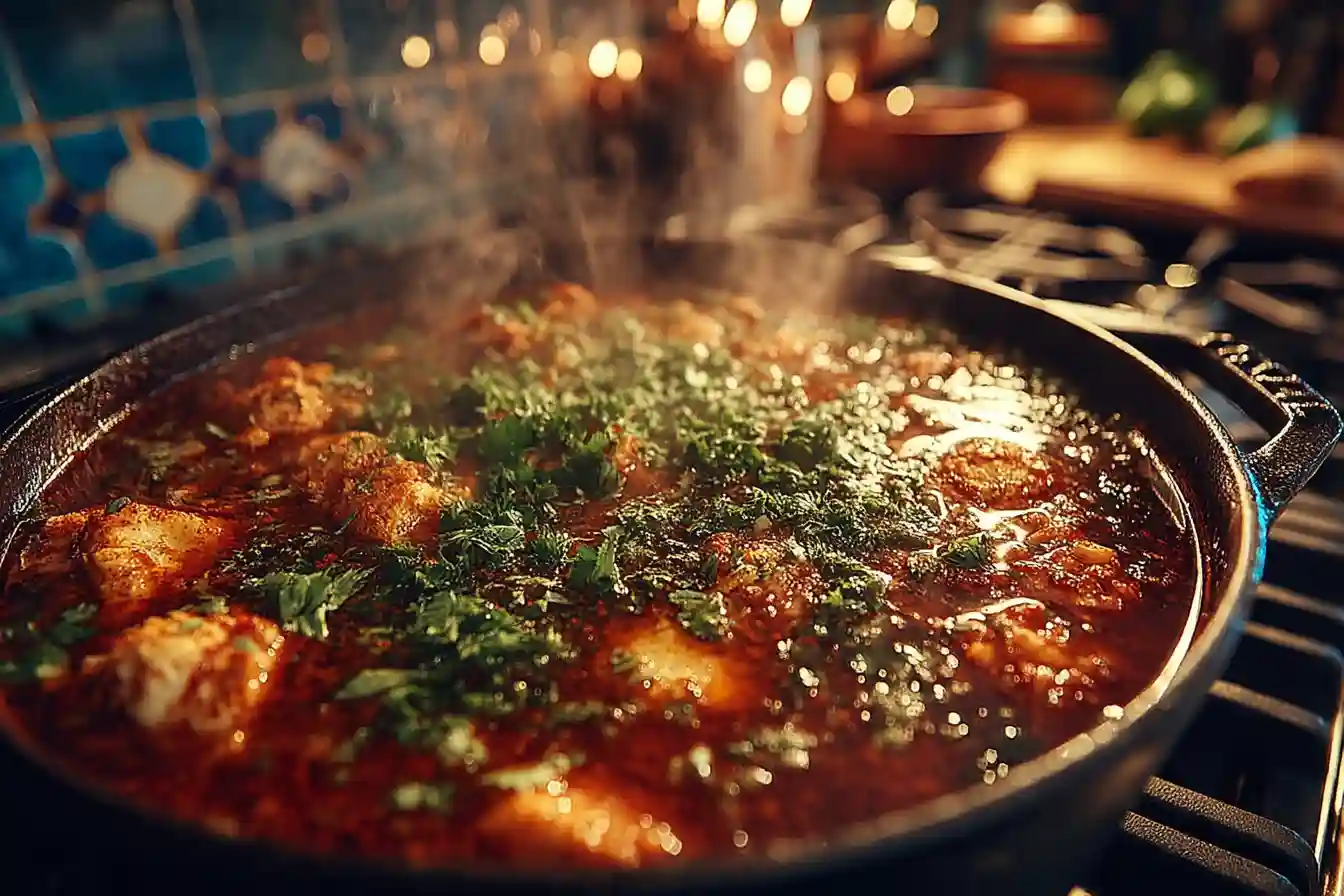
Variations, Tips, and Cultural Touches
Regional Twists: From Guerrero to Jalisco
Every region in Mexico puts its own stamp on Pozole Rojo. In Guerrero, it’s known for deep chile flavor and a slightly thicker broth. The chiles are toasted longer, giving the dish a smoky intensity that’s unforgettable. In Jalisco, the broth is lighter, and cooks often add a touch of epazote or cilantro near the end for a fragrant finish.
Other areas embrace creative spins, turning Pozole Rojo into a dish that reflects local ingredients. Some use vegetables like squash blossoms or green beans to add freshness. Others introduce a splash of lime juice for tang. The one thing that never changes is the respect for time slow simmering and layering flavor step by step.
Even outside Mexico, home cooks experiment while honoring tradition. I’ve seen people make a quick weeknight version using canned hominy and pre-made chile paste, yet it still captures that comforting essence. Whether you go classic or modern, Pozole Rojo remains a dish built on care and connection.
Tips for Making Pozole Rojo Ahead and Storing It
One of the best things about Pozole Rojo is how beautifully it improves overnight. The flavors deepen as they rest, making it an ideal dish to prepare ahead. If you’re planning a gathering, cook it a day early, refrigerate it, and reheat gently the next day. The broth thickens slightly, and every spoonful feels even more robust.
When storing leftovers, keep the hominy and broth together in an airtight container. It stays fresh for up to four days in the refrigerator. If freezing, let it cool completely before transferring it to freezer-safe bags. When reheated, add a splash of water or broth to restore the consistency.
To refresh the toppings, always cut new radishes and lettuce before serving. A drizzle of lime juice just before eating wakes up the flavors again. Whether freshly made or reheated, Pozole Rojo keeps its soul intact warm, fragrant, and ready to bring people together.
Cooking it isn’t just about filling a pot; it’s about carrying forward a tradition. Every batch tells a story of family, patience, and celebration the essence of real Mexican comfort food.
FAQ About Pozole Rojo
What are the ingredients in Pozole Rojo?
The essential ingredients for Pozole Rojo are hominy, dried red chiles (such as guajillo and ancho), garlic, onion, oregano, and salt. Traditionally, it’s made with a rich broth that gets its deep color from the blended chiles. However, it can also be made vegetarian by using vegetable stock and adding hearty vegetables like zucchini or mushrooms. The secret lies in slow cooking and layering those smoky, earthy chile flavors that define this classic Mexican stew.
What does Pozole contain?
Pozole Rojo is a hearty stew made primarily with hominy large, puffy corn kernels that give the dish its signature bite. It also includes a flavorful red chile broth and a mix of seasonings like garlic, onion, and oregano. Each bowl is served with traditional toppings such as shredded lettuce, sliced radishes, lime wedges, chopped onions, and dried oregano. Together, these create a perfect balance of spice, crunch, and freshness in every spoonful.
What spices are used in Pozole?
The main spice in Pozole Rojo is Mexican oregano, which adds a warm, slightly citrusy flavor that complements the red chile base beautifully. Other spices often used include bay leaves, cumin, and a hint of smoked paprika. These spices deepen the flavor of the broth and enhance the natural sweetness of the chiles without overpowering the dish. The result is a stew that feels both rustic and refined.
How is Pozole Rojo eaten?
Pozole Rojo is traditionally served hot in deep bowls and enjoyed with a variety of fresh toppings. Each person customizes their bowl adding lettuce or cabbage for crunch, radishes for sharpness, lime for brightness, and oregano for aroma. It’s usually eaten with crispy tostadas or warm corn tortillas on the side. The joy of eating pozole comes from that mix of textures and the communal spirit of sharing a meal made with love.

Conclusion
Cooking Pozole Rojo is more than following a recipe it’s connecting with history, flavor, and family. From the slow-simmered broth to the bright, crunchy toppings, every part tells a story. Whether you make it vegetarian or traditional, the essence remains the same: comfort and togetherness.
I still remember the first time I made Pozole Rojo on my own the kitchen smelled like my grandmother’s, warm and full of promise. That’s the beauty of this dish: it reminds us that home isn’t a place, it’s a feeling stirred into every pot we share.
So, grab your hominy, your favorite chiles, and take your time. Because once you ladle that first bowl, you’ll know exactly why Pozole Rojo has been loved for generations.
For more recipes follow me in facebook and pinterest.
Print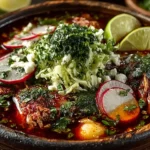
Pozole Rojo: The Ultimate Traditional Mexican Hominy Stew Recipe
- Total Time: P0DT1H25M
- Yield: 6 servings 1x
- Diet: Vegetarian
Description
A rich and flavorful traditional Mexican hominy stew simmered with red chiles, garlic, and spices. This vegetarian Pozole Rojo is hearty, aromatic, and perfect for gatherings or cozy weekends.
Ingredients
- 2 cups dried hominy (or 3 cans pre-cooked hominy, rinsed)
- 6 dried guajillo chiles
- 3 dried ancho chiles
- 1 medium white onion
- 4 cloves garlic
- 2 tsp salt (or to taste)
- 1 tsp ground cumin
- 1 tsp Mexican oregano
- 1 bay leaf
- 2 tbsp olive oil
- 8 cups vegetable broth
- Toppings: shredded lettuce, sliced radishes, chopped onion, lime wedges, dried oregano
Instructions
1. Rinse the hominy under cold water and place it in a large pot. Add water and simmer until kernels bloom and soften.
2. Remove stems and seeds from guajillo and ancho chiles. Toast them lightly in a dry pan until fragrant.
3. Soak the toasted chiles in warm water for 10 minutes to soften.
4. Blend chiles with garlic, onion, and 1 cup of broth until smooth. Strain the mixture for a silky texture.
5. In a large pot, heat olive oil. Add the chile sauce and cook for 3–4 minutes, stirring often.
6. Add the cooked hominy and vegetable broth to the pot. Stir in cumin, oregano, bay leaf, and salt.
7. Simmer uncovered for 30 minutes, allowing flavors to deepen.
8. Remove bay leaf and adjust seasoning if needed.
9. Serve hot in deep bowls with toppings: lettuce, radishes, onion, lime, and oregano.
Notes
For added texture, you can include diced zucchini or mushrooms.
Make the broth a day ahead — the flavors become even richer after resting.
Store leftovers in an airtight container for up to 4 days in the refrigerator or freeze for up to 3 months.
- Prep Time: P0DT0H25M
- Cook Time: P0DT1H00M
- Category: Soups & Stews
- Method: Simmering
- Cuisine: Mexican
Nutrition
- Serving Size: 1 bowl (about 350 ml)
- Calories: 260
- Sugar: 4g
- Sodium: 600mg
- Fat: 8g
- Saturated Fat: 1g
- Unsaturated Fat: 6g
- Trans Fat: 0g
- Carbohydrates: 38g
- Fiber: 7g
- Protein: 7g
- Cholesterol: 0mg

